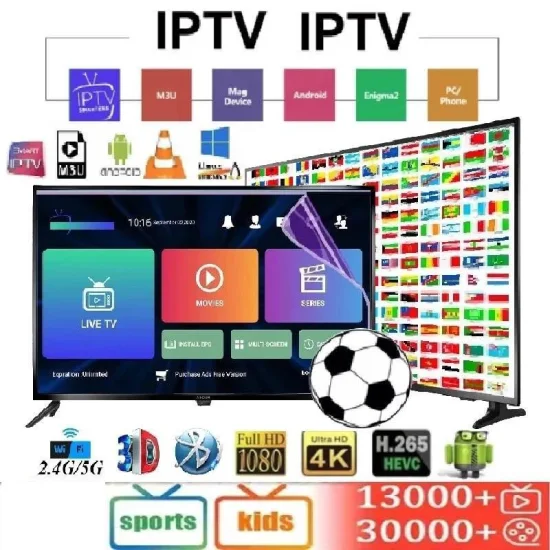Exactly How IPTV Works: A Step-by-Step Overview to Web Method Television Technology
Internet Method Tv (IPTV) has actually reinvented the means we take in tv content, using a brand-new world of opportunities with the power of the net. Understanding the details of exactly how IPTV works can drop light on the innovation that drives this ingenious type of media shipment. From the basic principles of IPTV to the complex procedure of web content shipment, each step plays a critical duty in guaranteeing a seamless viewing experience. In this overview, we will certainly reveal the hidden systems that make IPTV a remarkable fusion of innovation and enjoyment.
IPTV Essentials
In comprehending IPTV essentials, it is pivotal to grasp the essential operations of this innovation in delivering tv web content online. IPTV, which stands for Web Method Television, uses Internet Protocol (IP) networks to transfer tv content to users' devices. Unlike typical techniques of relaying tv material through wire or satellite signals, IPTV streams media via high-speed web connections.

Furthermore, IPTV permits interactive capacities, such as video as needed (VOD) and electronic program overviews (EPG), enhancing the individual experience by supplying even more control and adaptability in accessing content. On the whole, comprehending the fundamentals of IPTV establishes the foundation for discovering its advanced capabilities and the advantages it uses to modern television intake.
Material Delivery Refine
Efficient material shipment in IPTV systems involves a well-structured process that makes sure seamless transmission of television web content over IP networks. The content shipment process in IPTV begins with the creation of the video material, which is then encoded into digital layout appropriate for IP transmission. This encoded web content is then firmly saved on servers recognized as media web servers. When a visitor demands particular material, the IPTV system fetches the requested information from the media servers and supplies it to the viewer's tool online.

Middleware Functionality
With the combination of middleware, IPTV systems gain enhanced performance over at this website that streamlines customer interaction and web content management. One of the vital functions of middleware in IPTV is to make it possible for customized customer experiences by offering attributes such as interactive program guides, video-on-demand services, interactive advertising and marketing, and user choices management.
Device Compatibility
Given the critical duty of middleware in making it possible for smooth interaction and web content management in IPTV systems, a vital aspect to think about is the compatibility of tools utilized for accessing the IPTV solutions. Device compatibility is vital for making sure a smooth user experience and optimal performance when accessing IPTV content.
In the context of IPTV, tool compatibility describes the capability of a gadget to successfully interact with the IPTV service, present material properly, and sustain the required protocols and codecs for streaming video clip web click to find out more content over the web. Various gadgets, such as smart TVs, set-top boxes, smartphones, tablet computers, and computers, might have differing degrees of compatibility with IPTV services.
To ensure a seamless watching experience, it is very important for customers to choose tools that work with the certain IPTV service they are using. In addition, IPTV company need to provide support for a vast array of tools to accommodate the diverse demands of their individual base. By focusing on tool compatibility, both individuals and company can boost the overall IPTV experience.
High Quality of Solution (QoS)
Thinking about the crucial role of preserving a high criterion of performance and integrity in IPTV systems, guaranteeing constant Quality of Solution (QoS) stays a fundamental element of the user experience. QoS in IPTV refers to the ability of the system to provide web content with minimal interruptions, high resolution, and fast packing times. To achieve optimum QoS, various factors require to be addressed. Network data transfer is vital to support high-grade video clip streaming without buffering or pixelation. In addition, latency, jitter, and package loss should be decreased to enhance the seeing experience.
Company use QoS systems such as website traffic prioritization, buffering, and error modification to preserve a secure IPTV service. By focusing on IPTV web traffic over less time-sensitive information, carriers can guarantee smooth playback even during optimal use hours. Buffering aids make up for network fluctuations, while error adjustment methods improve data stability.
Continual tracking and optimization of QoS criteria are essential to adjust to transforming network conditions and user demands. Ultimately, a durable QoS framework is crucial for providing a smooth and pleasurable IPTV experience to customers.
Conclusion
In final thought, IPTV operates via the transmission of tv material over net procedure networks. The modern technology involves a systematic procedure of web content shipment, helped with by middleware capability to ensure compatibility across different tools. High quality of Solution plays a crucial duty in preserving the effectiveness and integrity of IPTV services. Understanding the fundamental concepts of IPTV is important for realizing the complexities of this cutting-edge tv technology.